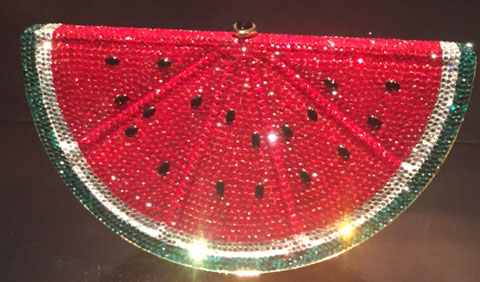
Handbag History: How Judith Leiber Came to Create Her Famous Purses
 The impetus for Judith Leiber’s game-changing minaudières, exquisite mini-handbags, came not from a carefully thought-out and executed design plan, but from a blooper. Let’s go back to the beginning though: born Judith Peto and raised in Budapest, the fabled handbag designer first studied chemistry in London (to prepare for a career in cosmetics) and then apprenticed at the Hungarian Jewish firm of Pessl, where she learned to cut and mold leather, make patterns, frame and stitch handbags. She was the first woman graduated to master craftswoman, and the first woman to join the Hungarian Handbag Guild in Budapest.
The impetus for Judith Leiber’s game-changing minaudières, exquisite mini-handbags, came not from a carefully thought-out and executed design plan, but from a blooper. Let’s go back to the beginning though: born Judith Peto and raised in Budapest, the fabled handbag designer first studied chemistry in London (to prepare for a career in cosmetics) and then apprenticed at the Hungarian Jewish firm of Pessl, where she learned to cut and mold leather, make patterns, frame and stitch handbags. She was the first woman graduated to master craftswoman, and the first woman to join the Hungarian Handbag Guild in Budapest.
When the Nazis put her country in a chokehold, the company was shut down, but Judith was able to escape the war and, in 1947, moved with her husband, American-born Gerson Leiber, to New York. She soon found work with the fashion house Nettie Rosenstein and rose steadily through the ranks. Mamie Eisenhower wore a Leiber-designed Nettie Rosenstein bag to the presidential inauguration, putting Leiber squarely on the fashion map. After 12 years with Rosenstein, Judith went out on her own, forming Judith Leiber handbags in 1963. She created some 3,500 handbags in such materials as leather, suede, needlepoint, fur and Lucite. But the bags that arguably made her name and her reputation were the jewel-encrusted minaudières that Leiber began making in the late 1960s when an order of gold-plated brass frames arrived damaged; in order to salvage them, she used rhinestones to cover the discoloration. The rest is handbag history, as the current Museum of Art and Design exhibition Judith Leiber: Crafting a New York Story (April 4, 2017 to August 6, 2017) can attest.



